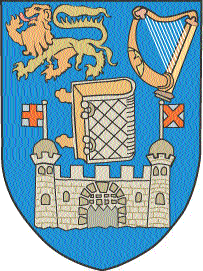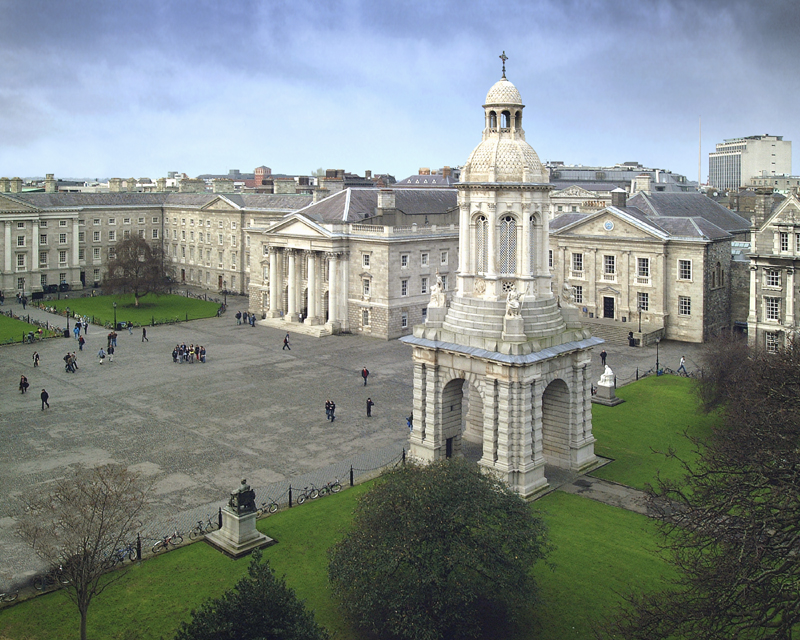
Department of Political Science, Trinity College Dublin
Michael Gallagher

 |
Department of Political Science, Trinity College Dublin Michael Gallagher |
 |
How Ireland Voted 2016
web page
This page contains information about the book How Ireland Voted 2016: the election that nobody won, 327 pp + lii (379 in all). ISBN 978-3-319-40888-0 paperback. For full details see the Palgrave site. It was published in mid-November 2016. The price in Ireland is 30 euro. The list of contents of the book gives a good idea of the ground it covers. For more information on the election, click here.
The book was launched in Triss (Trinity Research in Social Science) on 6 December 2016 by Micheál Martin TD, leader of Fianna Fáil.
What it's about
This volume in the How Ireland Voted series, the eighth (the first was about the 1987 election), analyses and conveys the excitement of the election that took place in Ireland on 26 February 2016 and its aftermath.
The first three chapters analyse pre-election developments. Chapter 1 (by Gary Murphy, see first page) traces the background to the election by outlining the dramatic events of the previous five years: the successes on the macro-economic front, coupled with setbacks in referendums and some calamitous results in local and European elections. Chapter 2 (by Rory Costello, Paul O'Neill and Robert Thomson, see first page) tackles the question of whether the Fine Gael-Labour government had a good record on fulfilment of the pledges those parties had made during the 2011 election campaign. It finds that, contrary to widespread assumptions, most of the outgoing government's pledges were at least partly fulfilled, and indeed a significant number of Fianna Fail's pledges were also fulfilled even though that party spent the entire term in opposition. Chapter 3 (by Theresa Reidy, see first page) focuses on the selection of the parties' candidates, which was the result of interplay between central bodies and local members, complicated on this occasion by the requirement of a degree of gender balance. The chapter also presents data on the demographic and political backgrounds of the candidates selected.
The next three chapters consider various aspects of the campaign. Chapter 4 (by Pat Leahy, see first page) reconstructs the course of the campaign and, based on interviews with key personnel, it presents and assesses the parties' perspectives on what went right and what went wrong for them. It tackles the mystery of why, with the economy overall in much better shape than anyone would have predicted in 2011, both government parties nonetheless lost votes heavily. In Chapter 5 six candidates give their personal accounts of what it was like to face the voters. First-time TDs from the largest three parties (FG, FF and SF) explain their successful campaign strategies, while a defeated Labour minister reflects on his and his party's campaign. An incumbent Independent TD explains how she was re-elected despite seeming certain to lose her seat, and the first Green Party candidate ever elected at a Seanad election reveals how this unlikely result was achieved.
Chapters 6 and 7 analyse different aspects of the results themselves. Chapter 6 (by Michael Gallagher, see first page) dissects the votes and seats won by the parties, analysing the performance of each and how the picture adds up collectively to the most fragmented party system the Irish state has ever known. It also considers whether the betting market can be used as a reliable predictor of election results (discovering a hint of gender bias in the betting market), and analyses the composition of the new parliament. Chapter 7 (by Michael Marsh and Gail McElroy, see first page) analyses survey data to investigate why people voted as they did, and in particular why voters rejected a government that could point to success in managing the macro-economy. It finds that class voting, while still muted, is becoming more prominent, and that while voters generally believed that the economy had improved, they were less convinced that their own economic circumstances had done so, and that voters were, moreover, disinclined to give the government any credit for such improvements as had taken place.
Chapter 8 (by Fiona Buckley, Yvonne Galligan and Claire McGing, see first page) assesses the impact of the newly introduced candidate gender quotas, both on the numbers of candidates selected and on the number of TDs elected, showing that while women are still very much under-represented in the Dail, there are significantly more women in the 32nd Dail than in any of its predecessors. It analyses the backgrounds and electoral performance of the female candidates, successful and unsuccessful. Chapter 9 (by Liam Weeks, see first page) focuses on an aspect of Irish politics that is almost unique among developed countries, namely the strong presence in parliament of Independents. It places the 2016 result in context, assesses the reasons for their exceptional success in Ireland, and by analysing survey data is able to explore the voter attitudes that underpin support for Independents.
In Chapter 10 (by Mary C. Murphy, see first page) the election of the Seanad, Ireland's upper house of parliament, is analysed; the result was unprecedented, with smaller parties and Independents faring better than ever before and the government left without an overall majority. The election is placed in the context of the discussion of Seanad reform that followed the defeat in a 2013 referendum of a proposal to abolish the institution entirely. Chapter 11 (by Eoin O'Malley, see first page), based on published accounts and on confidential interviews with participants, discusses the construction of the new government, which took an unprecedented 10 weeks and resulted in a government that fell much further short of an overall majority in the Dáil than any previous government had. Finally, Chapter 12 (by David Farrell and Jane Suiter, see first page) examines the election in context, highlighting the very high levels of voter volatility displayed. It considers the implications not just for the party system but also for the functioning of the entire political system, discussing whether in the era of the much-vaunted 'new politics', Ireland might move to the 'consensus government' end of Arend Lijphart's famous 'majoritarian-consensus' spectrum. Appendices to the book(see first page) contain the full election results, information on all 158 TDs and on government ministers, and a great deal of other relevant background information, and there is a comprehensive Index (see first page).
At the front of the book there is a Chronology of the election campaign (see first page), and this is followed by a selection of 41 outstanding full-colour photographs and campaign literature that capture the spirit of election 2016.
Reviews / endorsements
A number of endorsements:
Professor John Curtice, University of Strathclyde, Glasgow
'Here some of the finest scholars of the subject explain how the near century-old traditional patterns of Irish electoral politics have been disrupted like never before'.
Professor Michael Laver, New York University
'A well-written, timely and authoritative analysis of this fascinating Irish election. What on earth is happening to the traditional parties? A respected team of seasoned academics tell us all we need to know.'
Professor Jane Green, University of Manchester
'A brilliant combination of fact, explanation, insight and detail. How Ireland Voted 2016 is an excellent overview of an election that marks a crucial time point in an evolving picture of change in Irish politics.'
Professor Sara Hobolt, London School of Economics
'This volume is a must-read for anyone interested in Irish electoral politics'.
Who wrote it
The book contains contributions by academics from Dublin City University, NUI Maynooth, Queen's University Belfast, Trinity College Dublin, University College Cork, University College Dublin, University of Limerick, University of Strathclyde, by the deputy political editor of the Irish Times, and by six candidates at the election (four elected to the Dail and one elected to the Seanad). It was edited by Michael Gallagher and Michael Marsh, both of Trinity College Dublin.
Contributors:
Fiona Buckley, University College Cork
Rory Costello, University of Limerick
David M. Farrell, University College Dublin
Michael Gallagher, Trinity College Dublin
Yvonne Galligan, Queen's University Belfast
Pat Leahy, Irish Times
Gail McElroy, Trinity College Dublin
Claire McGing, NUI Maynooth
Michael Marsh, Trinity College Dublin
Gary Murphy, Dublin City University
Mary C. Murphy, University College Cork
Eoin O'Malley, Dublin City University
Paul O'Neill, University of Limerick
Theresa Reidy, University College Cork
Jane Suiter, Dublin City University
Robert Thomson, University of Strathclyde
Liam Weeks, University College Cork
Peter Burke, Fine Gael TD
Jack Chambers, Fianna Fail TD
Donnchadh Ó Laoghaire, Sinn Fein TD
Grace O'Sullivan, Green Party senator
Maureen O'Sullivan, Independent TD
Alex White, former Labour minister
How to order
Through your local bookshop, or online.
If you have any questions, contact mgllgher (add @tcd.ie)
| Go to TCD home | Political Science home | MG home |
Last updated 5 July, 2018 4:37 PM